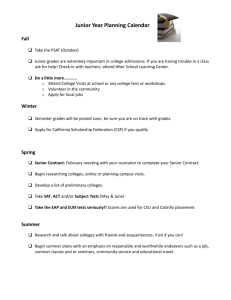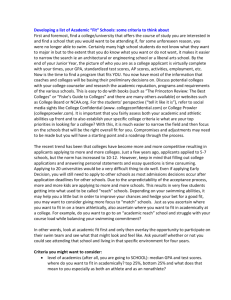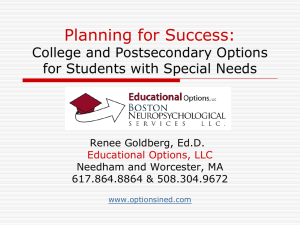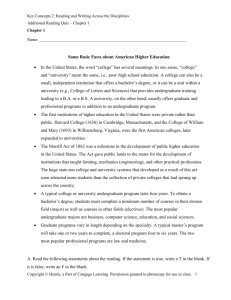American Universities and Colleges 16th edition, James J
advertisement
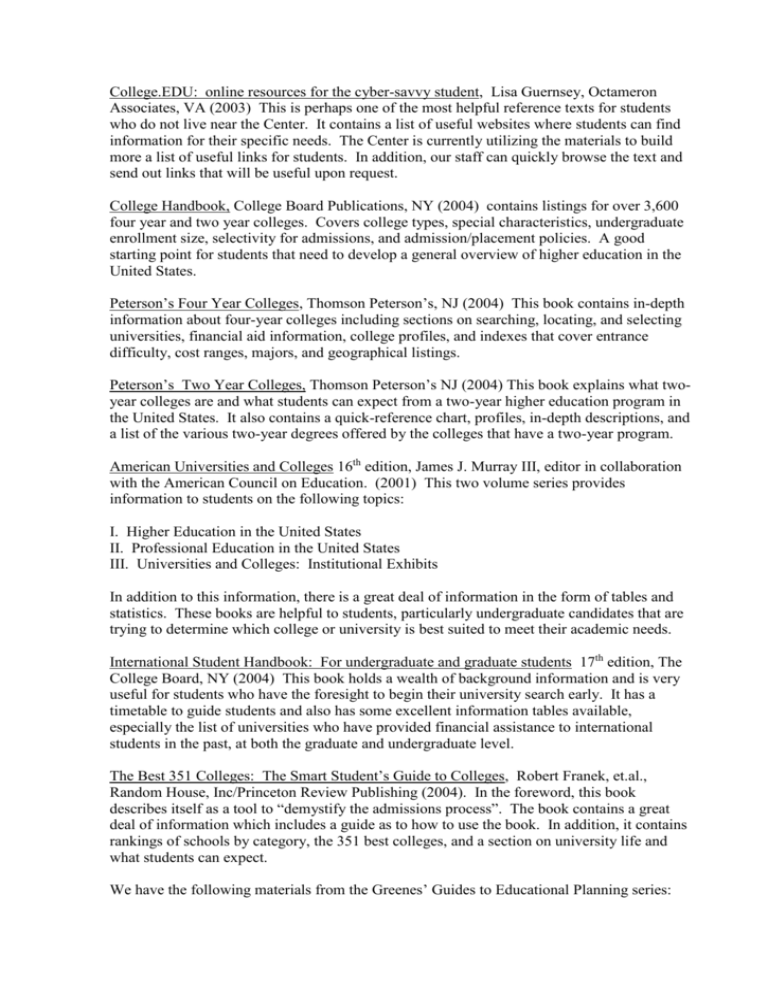
College.EDU: online resources for the cyber-savvy student, Lisa Guernsey, Octameron Associates, VA (2003) This is perhaps one of the most helpful reference texts for students who do not live near the Center. It contains a list of useful websites where students can find information for their specific needs. The Center is currently utilizing the materials to build more a list of useful links for students. In addition, our staff can quickly browse the text and send out links that will be useful upon request. College Handbook, College Board Publications, NY (2004) contains listings for over 3,600 four year and two year colleges. Covers college types, special characteristics, undergraduate enrollment size, selectivity for admissions, and admission/placement policies. A good starting point for students that need to develop a general overview of higher education in the United States. Peterson’s Four Year Colleges, Thomson Peterson’s, NJ (2004) This book contains in-depth information about four-year colleges including sections on searching, locating, and selecting universities, financial aid information, college profiles, and indexes that cover entrance difficulty, cost ranges, majors, and geographical listings. Peterson’s Two Year Colleges, Thomson Peterson’s NJ (2004) This book explains what twoyear colleges are and what students can expect from a two-year higher education program in the United States. It also contains a quick-reference chart, profiles, in-depth descriptions, and a list of the various two-year degrees offered by the colleges that have a two-year program. American Universities and Colleges 16th edition, James J. Murray III, editor in collaboration with the American Council on Education. (2001) This two volume series provides information to students on the following topics: I. Higher Education in the United States II. Professional Education in the United States III. Universities and Colleges: Institutional Exhibits In addition to this information, there is a great deal of information in the form of tables and statistics. These books are helpful to students, particularly undergraduate candidates that are trying to determine which college or university is best suited to meet their academic needs. International Student Handbook: For undergraduate and graduate students 17th edition, The College Board, NY (2004) This book holds a wealth of background information and is very useful for students who have the foresight to begin their university search early. It has a timetable to guide students and also has some excellent information tables available, especially the list of universities who have provided financial assistance to international students in the past, at both the graduate and undergraduate level. The Best 351 Colleges: The Smart Student’s Guide to Colleges, Robert Franek, et.al., Random House, Inc/Princeton Review Publishing (2004). In the foreword, this book describes itself as a tool to “demystify the admissions process”. The book contains a great deal of information which includes a guide as to how to use the book. In addition, it contains rankings of schools by category, the 351 best colleges, and a section on university life and what students can expect. We have the following materials from the Greenes’ Guides to Educational Planning series: Presenting Yourself Successfully to Colleges, Howard R. Greene and Mathew W. Greene, HarperCollins NY (2001) This guide is especially useful to students in guiding them through the application process. It covers the writing of essays for submission to admission officers, and describes how students can communicate their strengths through standard admission forms as well as supplementary documentation. The Public Ivies: America’s Flagship Public Universities , Howard R. Greene and Mathew W. Greene, HarperCollins NY (2001) This book guides students in the selection of a public university as opposed to a private institution. It explains to students how to get a premier education at a public college or university, the difference between public and private institutions, what it takes to succeed at a public university, and how to evaluate public university and find the right match. The Hidden Ivies: Thirty Colleges of Excellence , Howard R. Greene and Mathew W. Greene, HarperCollins NY (2001). This book explores a “small, distinct cluster of colleges and universities that are available to gifted college-bound students”. This books guides students in how to get an Ivy League education at a college that is comparable in excellence, explains why these colleges are exceptional, describes campus life from the student point of view, and assists students in finding the college that is right. The Center also has two publications by Loren Pope, Director of the College Placement Bureau: Looking beyond the Ivy League: finding the college that’s right for you, Penguin Books, NY (1995) This guide assists students and parents in making informed choices about higher education. Pope began his work in rural Virginia where he worked in media and began to educate rural families as to how to make the right choice for the children’s education. Because of this approach, the book can also be quite helpful to international students who may also not be in touch with all the information necessary to make the right choice. Colleges that Change Lives: 40 schools you should know about even if you’re not a straightA student, Penguin Books, NY (2000), This book can also be quite helpful for internationals students especially students who are hoping for financial aid for academic achievement. The colleges in this guide are referred to as those that “work their magic on B and C students as well as on A students”. Although there is no certainty for students seeking financial aid, many of these colleges would be open to students that could bring both academic excellence and diversity to their educational programs. Game Plan for Getting into College, K. Patricia Aviezer, Peterson’s, a division of Thomson Learning, Canada (2000), “This text explains what students should do in the years leading up to college and emphasizes critical areas of the college selection and application process, including picking a college, applying, and paying college tuition”. Game Plan for Getting into Graduate School, Marion B. Castellucci, Peterson’s, a division of Thomson Learning, Canada (2000), This text covers the step by step process of applying to graduate school, covering areas from self-assessment, selection of a university, test-taking, application timetables, essay writing, and even includes worksheets to assist students in the process. Peterson’s Graduate & Professional Programs Thomson Peterson’s ((2005) This six volume series is designed to assist graduate students by providing information that is organized by specific fields of study. Each educational institution is described in detail including information on the student to professor ratio, the number of candidates in a program, the average cost of each program, whether fellowships or assistantships are available, as well as the financial assistance that has been previously provided to graduate students. Peterson’s Grants for Graduate and Postdoctoral Study, 5th edition, Petersons, Princeton, NJ (1998) This book explains the process of seeking grants and fellowships to students and postdoctoral candidates. One of the most useful sections of this book is the index in the back which contains a special characteristic index with a subsection of opportunities for which non-US citizens qualify. Graduate School: winning strategies for getting in with or without excellent grades, Dave G. Mumby, ProtoPress, Canada (1997) This book details the assessment process that students go through in order to gain acceptance into graduate school. Divided into three sections, the book covers the “truths and myths about graduate school”, application preparation, and suggests what students can do to go beyond the standard process and be sure that their applications receive strong consideration from admissions committees. Getting what you came for: the smart student’s guide to earning a master’s or Ph.D. (revised edition), Robert L. Peters, Farrar, Straus, and Giroux, NY (1997), This book provides in depth information on graduate school which includes what graduate school will be like, whether graduate school is a necessary step, discusses whether a student should work prior to graduate school, and how to select the right graduate school. In addition, the book also provides a great deal of background information for student such as “What is a thesis advisor” and addresses other issues that are specific to American graduate schools, such as building an academic reputation within the university system, time management, credentials, and financial aid. A Parent’s and Student-Athlete’s Guide to Athletic Scholarships: getting money without being taken for a [full] ride, Dion Wheeler, Contemporary Books, IL (2000), “This book provides the tools, devices, and strategies to give student-athletes the best opportunity to continue an athletic career in college and to receive financial aid based upon athletic ability.” The author also addresses issues such as negotiation with recruiters, college athletic associations that internationals may not be familiar with, and includes a helpful glossary of terminology. The Student Athlete’s Handbook: the complete guide for success, Perry Bromwell and Howard Gensler, John Wiley & Sons, Inc., USA, (1997), The book contains two parts, the first part is for students who are still in high school and covers strategy that includes academic, athletic, and social preparation as well as choosing the right school. Part II covers the actual university experience and extensive information on educational skills, people skills, and life after college and even contains information for athletes who are considering professional athletic careers. In addition, the book also has an NCAA guide for collegebound student athletes, and a sport-by-sport breakdown that includes every sport and how many colleges have programs in each sport. Iserson’s Getting into a Residency, Kenneth V. Iserson, Galen Press Ltd, AZ (2003), This book is much more extensive than the title indicates. For medical students from SCG, the book can provide a wealth of information. There are sections that are for medical students who have studied outside the US and Canada that will be particularly helpful. Film School Confidential: the insider’s guide to film school, Karin Kelly and Tom Edgar, The Berkeley Publishing Group, NY (1997) This book will “take you through the process with objective and ruthless evaluations of twenty-six film school programs across the country”. The book provides the information needed to apply, the curriculum you will study, and costs. Occupational Outlook Handbook 2004-2005, This book is one of the most widely used career information guides ever published. It assists student and professionals in determining what they can expect within their fields. It contains information about earnings, working conditions, advancement opportunities, as well as projected growth within each field. It can certainly help students make decisions about the academic majors and whether or not graduate school is for them. American Ways: a guide for Foreigners in the United States, Gary Althen, Intercultural Press, ME 04096 (2003) This guide extends far beyond simply assisting students that plan to seek higher education in the USA. The guide profiles life in America, American culture and tradition and even has a section explaining what happens when cultures clash. It is useful for anyone who plans to spend time in the United States. Library Hours: Monday to Friday 11.00 a.m. to 9.15 p.m. Saturday 11.00 a.m. to 3.00 p.m.



